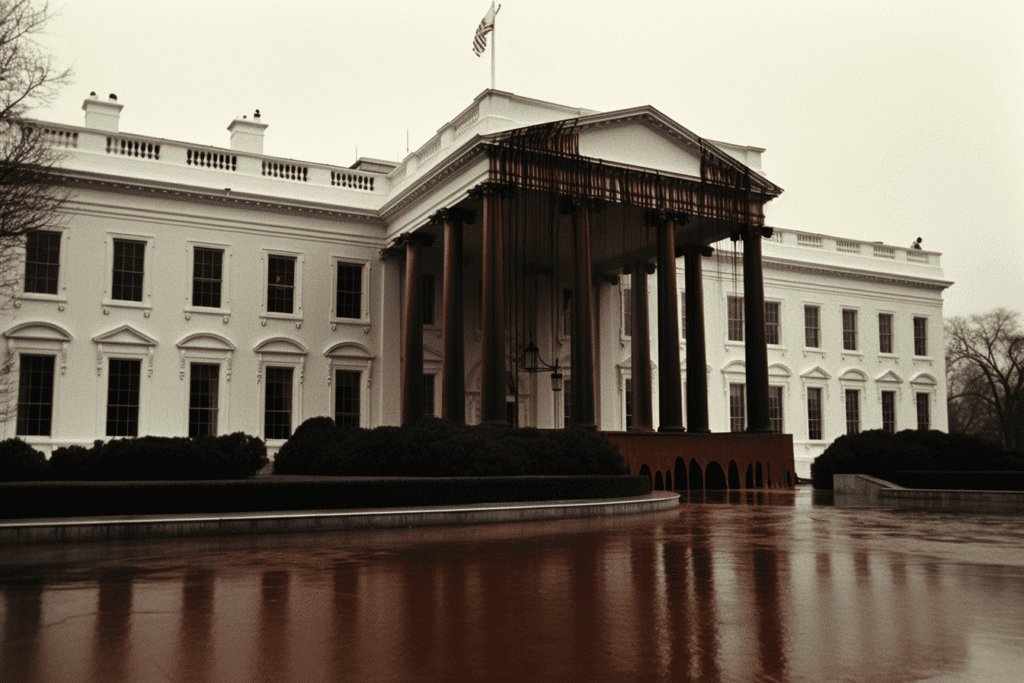
The global financial crisis (GFC) of 2007-2008, considered the most severe economic downturn since the Great Depression, left lasting impacts on the world economy, exposing the vulnerabilities inherent in the existing financial system.1 At the heart of the GFC was the petrodollar system, which links global trade to the US dollar and perpetuates a debt-based economy.2 This system has contributed to global economic instability and increased the likelihood of financial crises.
There’s an argument to be made that the current fiat currency system, with its inflationary nature and lack of tangible backing, is fundamentally flawed.3 An alternative asset-based monetary system, such as one built on Bitcoin, could provide a more stable and resilient economic foundation. This article aims to explore the connection between the petrodollar system, the GFC, and the potential benefits of a Bitcoin-based monetary system in mitigating the risks of future financial crises.
The Petrodollar System: A recap

The petrodollar system can be traced back to the early 1970s when the United States, led by President Richard Nixon, decided to abandon the gold standard, which had tied the value of the US dollar to a fixed amount of gold.2 This decision marked the end of the Bretton Woods system, which had governed global monetary policy since 1944.4 In response to the rising power of oil-producing countries and the need to maintain the US dollar’s dominance in international trade, the US government struck a series of agreements with Saudi Arabia and other OPEC countries in the early 1970s, culminating in the birth of the petrodollar system.5
Under the petrodollar system, oil-producing countries agreed to price and sell their oil exclusively in US dollars, which, in turn, generated a global demand for the US currency.6 The US dollar became the de facto global reserve currency, giving the United States significant influence over global trade and financial markets. As a result, the petrodollar system allowed the US to issue debt more easily and finance its deficits, contributing to the growth of a debt-based economy.7
The petrodollar system has significant ramifications including fostering global economic imbalances and contributing to the financialisation of commodities.8 Furthermore, the system’s reliance on the US dollar as the world’s reserve currency has led to concerns about the sustainability of the global financial system, particularly given the US’s rising national debt and the potential for currency devaluation.9 In this context, it is crucial to understand the petrodollar’s role in the global financial crisis and the potential benefits of an alternative monetary system.
The Petrodollar and the Global Financial Crisis

The petrodollar system played a significant role in the lead-up to the global financial crisis (GFC) of 2007-2008, contributing to several economic imbalances and vulnerabilities that ultimately led to the crisis.2 One key factor was the system’s inherent promotion of a debt-based economy. As oil-exporting countries accumulated large reserves of US dollars, they sought to invest these surpluses in dollar-denominated assets, primarily US government bonds and mortgage-backed securities.10 This influx of capital led to artificially low-interest rates, which encouraged excessive borrowing and the creation of asset bubbles, particularly in the US housing market.11
Another contributing factor was the inflationary nature of the fiat currency system, which was exacerbated by the petrodollar arrangement.3 As the US Federal Reserve pursued loose monetary policies to maintain low-interest rates, the global supply of US dollars increased, leading to a decline in the currency’s value and higher inflation rates. This inflationary environment incentivised speculative investments in riskier assets, such as mortgage-backed securities and other complex financial instruments, which ultimately played a central role in the GFC.12
The consequences of the GFC were far-reaching, with millions of people losing their jobs and homes, and many countries experiencing severe economic recessions.1 The crisis exposed the fragility of the global financial system and highlighted the need for a more resilient and stable monetary framework. In this context, the idea of a decentralised, asset-based monetary system, such as Bitcoin, maybe a potential solution to prevent future financial crises.13
The Fiat Standard

The current fiat currency system has fundamental flaws and contributes to economic instability and the risk of financial crises.3 The first flaw is the inflationary nature of fiat currencies, which are not backed by any tangible assets. This lack of backing allows central banks to create new money at will, leading to a continuous expansion of the money supply and, consequently, inflation.14 This inflationary environment played a significant role in the global financial crisis, as it encouraged speculative investments and the growth of unsustainable asset bubbles.12
The fiat system contributes to wealth inequality and the erosion of individual purchasing power. As central banks expand the money supply, the value of existing currency holdings diminishes, effectively reducing the purchasing power of money held by individuals.15 Furthermore, the newly created money tends to benefit those with access to credit and financial markets, exacerbating wealth inequality and promoting a debt-based economy.16
An alternative asset-based currency system could address many of these issues and provide a more stable and resilient economic foundation. Bitcoin has the potential to be the alternative to the fiat standard due to its decentralised nature and limited supply.13 In the following sections, we will examine Bitcoin’s unique properties and discuss how a Bitcoin-based monetary system could address the shortcomings of the petrodollar system and mitigate the risks of future financial crises.
Bitcoin: An Engineered Asset Based Alternative

Bitcoin is a decentralised digital currency that operates on a peer-to-peer network and uses cryptography to secure transactions and prevent double-spending.17 As an alternative to the fiat currency system, Bitcoin offers several unique properties that address the flaws of the petrodollar system and the risks associated with centralized monetary policy.
Limited Supply and Inflation Control
One of Bitcoin’s key features is its limited supply, which is capped at 21 million coins.13 This fixed supply makes Bitcoin inherently deflationary, as opposed to the inflationary nature of fiat currencies. Consequently, Bitcoin’s value tends to increase over time as demand for the currency grows, preserving and potentially enhancing individual purchasing power.18 The limited supply of Bitcoin could prevent the rapid expansion of credit and excessive risk-taking that contributed to the global financial crisis.13
Decentralisation and reducing Systemic Risk
Additionally, Bitcoin’s decentralized structure removes the need for central banks or other intermediaries, reducing the potential for manipulation and corruption within the financial system.13 Unlike the petrodollar system, which is heavily influenced by the monetary policies of the US Federal Reserve, Bitcoin’s monetary policy is determined algorithmically, ensuring a predictable and transparent issuance of new coins.13
Reduced Reliance on debt
Bitcoin’s asset-based nature also offers a potential solution to the debt-based economy perpetuated by the petrodollar system. By encouraging savings and sound money principles, Bitcoin can promote a more stable and resilient economic foundation that is less susceptible to the creation of unsustainable asset bubbles and the risks associated with excessive borrowing.13
Enhanced Transparency
Conclusion
While it is impossible to know for certain whether the Bitcoin system could have prevented the global financial crisis, its unique features suggest that it could have played a role in mitigating some of the risks associated with the debt-based petrodollar system. By reducing the reliance on debt, enhancing transparency, and promoting decentralisation, the Bitcoin system may create a more stable and resilient global financial environment.
A lot of economists that have studied the traditional Keynesian teachings will argue that it is a ridiculous notion to have a global economy on a fixed monetary system. There is no way to have two simultaneous global economies running at the same time to test this. There are, however, many examples of smaller civilisations historically that have thrived on fixed monetary systems. More importantly, the logic for a lot of theories that form the foundation of the Keynesian school are fundamentally flawed. We’ll take a look at the key differences between the Austrian school and Keynesian school of economics in the next section.
References
- Reinhart, C.M., and Rogoff, K.S., 2009. This time is different: Eight centuries of financial folly. Princeton University Press.
- Eichengreen, B., 2011. Exorbitant Privilege: The Rise and Fall of the Dollar and the Future of the International Monetary System. Oxford University Press.
- Ammous, S., 2021. The Fiat Standard: The Debt Slavery Alternative to Human Civilization. Lightning Source UK Ltd.
- Bordo, M.D., 1993. The Bretton Woods international monetary system: A historical overview. In: A Retrospective on the Bretton Woods System: Lessons for International Monetary Reform. University of Chicago Press, pp. 3-108.
- Spiro, D.E., 1999. The hidden hand of American hegemony: Petrodollar recycling and international markets. Cornell University Press.
- Gause, F.G., 2015. The international relations of the Persian Gulf. Cambridge University Press.
- Clark, J.R., and Hall, L.A., 2012. Petrodollar warfare: Oil, Iraq and the future of the dollar. Journal of Business & Economics Research (JBER), 10(3), pp. 125-134.
- Katusa, M., 2015. The Colder War: How the Global Energy Trade Slipped from America’s Grasp. John Wiley & Sons.
- Prasad, E.S., 2014. The Dollar Trap: How the U.S. Dollar Tightened Its Grip on Global Finance. Princeton University Press.
- Obstfeld, M., and Rogoff, K., 2009. Global imbalances and the financial crisis: Products of common causes. In Asia and the global financial crisis. Federal Reserve Bank of San Francisco, pp. 131-172.
- Rajan, R.G., 2010. Fault Lines: How Hidden Fractures Still Threaten the World Economy. Princeton University Press.
- Stiglitz, J.E., 2010. Freefall: America, Free Markets, and the Sinking of the World Economy. W.W. Norton & Company.
- Ammous, S., 2018. The Bitcoin Standard: The Decentralized Alternative to Central Banking. John Wiley & Sons.
- Mises, L.V., 1998. Human Action: A Treatise on Economics. Ludwig von Mises Institute.
- Rothbard, M.N., 2008. The Mystery of Banking. Ludwig von Mises Institute.
- Piketty, T., 2014. Capital in the Twenty-First Century. Harvard University Press.
- Nakamoto, S., 2008. Bitcoin: A Peer-to-Peer Electronic Cash System. https://bitcoin.org/bitcoin.pdf
Luther, W.J., 2016. Bitcoin and the future of digital payments. The Independent Review, 20(3), pp. 397-404.
These articles were designed to make these concepts more palatable. If you’re interested in reading a more in-depth perspective on the transition to fiat currency, consider the following:
ENDEVR. “End of the Road: How Money Became Worthless.” Youtube documentary, https://www.youtube.com/watch?v=NJd6RKsY5H4
Saifedean Ammous, “The Bitcoin Standard: A Decentralised Alternative to Central Banking”. Wiley, 2018
Saifedean Ammous, “The Fiat Standard: The Debt Slavey Alternative to Human Civilization”. Wiley, 2021
Investopedia. “How Petrodollars affect the US dollar.” https://www.investopedia.com/articles/forex/072915/how-petrodollars-affect-us-dollar.asp
Wight, D.M. “Oil Money: Middle East Petrodollars and the Transformation of US Empire, 1967–1988.” New York: Cornell University Press, 2017
Gladstein, Alex. “Uncovering the hidden costs of the Petrodollar.” Bitcoin Magazine, https://bitcoinmagazine.com/culture/the-hidden-costs-of-the-petrodollar

Ruki is a passionate Bitcoin educator who firmly believes in the principles of the Austrian School of Economics. As a sound money advocate he recognises its benefits to individuals and society as a whole. He is dedicated to empowering those without financial access to take control and build a more secure future.
